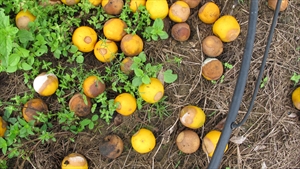Fruit-piercing moth
Pacific Pests, Pathogens and Weeds - Online edition
Pacific Pests, Pathogens & Weeds
Citrus fruit piercing moth (113)
Eudocima fullonia; previously Othreis fullonia
Asia, Africa, North America (Hawaii), Oceania. It is recorded from American Samoa, Australia, Cook Islands, Fiji, French Polynesia, Guam, Federated States of Micronesia, New Caledonia, New Zealand, Niue, Northern Mariana Islands, Palau, Papua New Guinea, Samoa, Solomon Islands, Tonga, Vanuatu, and Wallis & Futuna.
A wide range of cultivated and wild fruits, including banana, citrus, 5-corner fruit, guava, mango, passionfruit, pineapple, and in outbreak years, capsicum, melon and tomato.
The adult (Photo 1) does the damage, not the caterpillars. The moth has a feeding tube (proboscis) that is up to 25 mm long, barbed and strong enough to penetrate tough rind of fruits and to suck out the juices. The hole then becomes an entry point for fungi and bacteria, and rots develop, and fruits fall (Photos 2&3). Damaged fruit produce a smell that attracts other moths.
Eggs are laid on species of Erythina. They are yellowish, almost round, laid singly or in batches of several hundred. They hatch in about 3 days, and go through five stages over about 3 weeks. The caterpillars are dark brown to black when together in large numbers, and pale yellow to green when solitary. The pupae develop in silken cocoons on leaves that they draw together. After 2-3 weeks the adults emerge, mate a few days later, and the female starts laying eggs - up to 750 - during a life of about 30 days.
Adult moths are about 5 cm long with wingspans up to 10 cm. The body is brown towards the front, and yellow-brown behind, with brown forewings flecked with green and white (more in the female), and orange hind wings with a wide black comma-like mark, and a black border (Photo 1).
The damage caused by the moth fluctuates greatly. In most years, the percentage of damaged fruit is small, but occasionally there are serious outbreaks, usually after droughts, when crops of citrus and tomatoes are totally destroyed. In Samoa, losses in citrus and 5-corner fruit exceed 30%, and on Viti Levu, Fiji, losses of fruit crops (mainly citrus) are 10-15%, rising to 90% and 70%, respectably, in outbreak years. At these times, loses in tomato and capsicum are also high.
Look for the adult moths after sunset, beginning a few weeks before harvest. Look for their large red-glowing eyes in torchlight. Look for fruit with characteristic small holes; often, on citrus, there are wide discoloured rots surrounding the holes, and fallen fruit.
This is a very difficult pest to control, mainly because insecticides cannot be applied near the time that fruits are ripe, adult moths are not attracted to light, and the caterpillars develop on trees that are common but often far from the fruit-growing areas. The adult moths rest on weeds near the food source during the day, waiting for night, again making them difficult targets for insecticide programs. The moths are strong fliers.
NATURAL ENEMIES
In most countries, there are natural enemies of Eudocima. For instance, Trichogramma nr. papilionis is present in Fiji, and Trichogramma sp. and Ooencyrtus crassulus are endemic to Samoa. However, none of them are able to maintain Eudocima populations below economic levels. Furthermore, severe outbreaks of the moth occur after droughts. When droughts occur the adult moths migrate to higher, cooler areas, escaping the influence of natural enemies, and these suffer a decline in number. When rains come once again, and host trees produce a flush of new leaves, the remaining moths breed rapidly and outbreaks occur.
Several attempts have been made in Pacific island countries to introduce natural enemies to control Eudocima. From New Caledonia, the tachnid fly, Winthemia caledoniae, was introduced to Fiji and Tonga, and Ooencyrtus sp. to Samoa, with unknown results. By contrast, introduction of Telenomus lucullus from Papua New Guinea to Samoa in 1988 was successful, but the introduction of Ooencyrtus sp. was not. Other potential candidates are the effective egg parasite, Trichogramma ostriniae, reported in Hawaii, and Euplectrus sp., a larval ectoparasitoid from India, introduced into Guam in 2000.
CULTURAL CONTROL
- Early harvest is a possibility, although fruit quality suffers.
- Bagging of fruit, or wrapping in newspaper, is also a possibility, but it is labour intensive, and difficult to do on large trees, such as mango and breadfruit. The use of nets is effective, but it, too, is expensive. Like fruit wrapping, nets are also a defence against birds and bats.
- Removal of Erythrina, the host of the caterpillars, has both advantages and disadvantages: there may be reduction in damage caused by the moth, especially in outbreak years, but the tree provides shade for cattle and crops, living fence posts, the flowers provide food for bats, and in some places they have cultural significance.
RESISTANT VARIETIES
None known.
CHEMICAL CONTROL
Not effective for the reasons stated above, and that there is only limited contact between moth and fruit when feeding. There are concerns, too, for human health, because applications to pesticides would be needed near the time of harvest for them to be effective.
AUTHOR Grahame Jackson
Information from Waterhouse DF, Norris KR (1987) Biological Control Pacific Prospects. Inkata Press. Assistance; and from Wilco Liebregts (pers. comm), Eco-Consult Pacific, Fiji. Photo 1 Gerald McCormack, Cook Islands Biodiversity & Natural Heritage. (http://cookislands.bishopmuseum.org/).
Produced with support from the Australian Centre for International Agricultural Research under project PC/2010/090: Strengthening integrated crop management research in the Pacific Islands in support of sustainable intensification of high-value crop production , implemented by the University of Queensland and the Secretariat of the Pacific Community.






